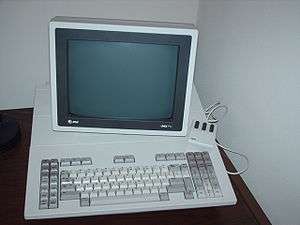AT&T Unix PC
The AT&T UNIX PC is a Unix desktop computer originally developed by Convergent Technologies[2] (later acquired by Unisys),[1] and marketed by AT&T in the mid- to late-1980s. The system was also known as PC-7300, and often dubbed the 3B1. Despite the latter name, the system had little in common with AT&T's line of 3B series computers. The system was tailored for use as a productivity tool in office environments and as an electronic communication center.[4]
 AT&T Unix PC | |
| Manufacturer | Convergent Technologies[1][2] |
|---|---|
| Type | Professional Computer |
| Release date | March 26, 1985[3] |
| Introductory price | $5,095-$7,000[3] |
| Media | 5¼-inch floppy disks,[2] optional quarter-inch cartridge tapes |
| Operating system | AT&T Unix v3.51[1] |
| CPU | Motorola MC68010 with custom Memory management unit clocked at 10Mhz[2] |
| Memory | 512KB to 4MB RAM[2] |
| Storage | Optional 10MB, 20MB, 40MB,[2] and 67MB hard drives[1] |
| Display | 720x348 pixel resolution[2] |
| Input | Keyboard, 3-button Mouse[2] |
Hardware configuration
- 10 MHz Motorola MC68010 (16 bit external bus, 32 bit internal) with custom, discrete MMU[2]
- Internal MFM hard drive, originally 10 MB[3], later models with up to 67 MB[1]
- At least 512K RAM on main board, expandable via expansion cards[2]
- 3 expansion slots[2]
- Monochrome green phosphor 12-inch (300 mm) monitor[2]
- Internal 300/1200 bit/s modem[2]
PC7300
The initial PC7300 model offered a modest 512 KiB[2] of memory and a small, low performance 10 MB hard drive.[3] This model, although progressive in offering a Unix system for desktop office operation, was underpowered and produced considerable fan and drive bearing noise even when idling. The modern-looking "wedge" design was innovative, and in fact the machine gained notoriety appearing in many movies as the token "computer."
AT&T 3B1
A later enhanced model was renamed "3B1".[1] The cover was redesigned to accommodate a full-height 67 MB hard drive.[1] This cover change added a 'hump' to the case, expanded onboard memory to 1 or 2 MB, as well as added a better power supply.[1]
Operating system
The operating system is based on Unix System V Release 2,[2] with extensions from 4.1 and 4.2 BSD, System V Release 3 and Convergent Technologies.[1] The last release was 3.51.[1]
Programming languages
Application software
- SMART System (Office Suite)
- dBASE III (DBM)[3]
- Informix (DBM)
- Oracle (DBM)
- Multiplan (Spreadsheet)[5][3]
Word processors
Expansion cards
- DOS-73 8086 co-processor card with 512K RAM, an RS-232C COM2 port and could be fitted with an 8087 math co-processor chip. It included MS-DOS 3.1. This board was designed and built for AT&T by Alloy Computer Products of Framingham MA.
- RAM card could be added using 512 KB RAM or 2 MB RAM cards, up to a maximum of 4 MB (2 MB on the motherboard and 2 MB on expansion cards).
- EIA/RAM combo cards contained extra RAM and two RS-232 serial ports.
- Dual EIA port card
- StarLAN – 1 Mbit/s (1BASE5) network over twisted-pair wire local area network typically used in star format
- Ethernet 10 Mbit/s LAN card and the Wollogong TCP/IP stack/drivers
- VoicePower card allowed for the capture and digital recording of voice conversations.
- Tape drive card provided interface for 23 MB MFM Tape Cartridge Drive.
- Expansion chassis card was hard-wired to Expansion Chassis (with five added slots)
Public domain software
The Store is a public domain software repository which was available for all 3B1 users.[9]
See also
- AT&T 6300 Plus
- DEC Professional (computer)
- IBM RT PC
- IBM System 9000
References
- "3b1 FAQ". unixpc.org. Retrieved 1 August 2019.
- Mayer, Alastair J. W. "System Review: The AT&T UNIX PC" (PDF). Byte. No. May 1986. pp. 254–262. Retrieved 2019-08-01.
- Howitt, Doran (1984-04-08). "At Last, AT&T's 7300/Unix PC". Infoworld. p. 17. Retrieved 2019-08-01.
- AT&T, Select Code 999-601-311IS, AT&T UNIX PC Owner's Manual (1986)
- Satchell, Stephen (1985-09-23). "A Look at Software for AT&T's Unix PC". Infoworld. pp. 32–33. Retrieved 2019-07-30.
- http://unixpc.taronga.com/games/
- http://unixpc.taronga.com/comp.sources.3b1/volume01/
- http://unixpc.taronga.com/misc/
- http://unixpc.taronga.com/STORE/
External links
- AT&T Leapfrogs IBM With the Unix PC., InfoWorld, April 15, 1985, pp. 15–17
- The AT&T Unix PC, article from BYTE magazine Volume 10 Number 05: Multiprocessing (May 1985), pp. 98–106
- The AT&T Unix PC Review, article from BYTE magazine Volume 11 Number 05: Multiprocessing (May 1986), pp. 254–262
- comp.sys.3b1 FAQ
- AT&T 3B1/7300 (UNIX PC) Information
- AT&T UNIX PC at old-computers.com
- http://bitsavers.trailing-edge.com/pdf/att/3b1/
- http://www.unixpc.org